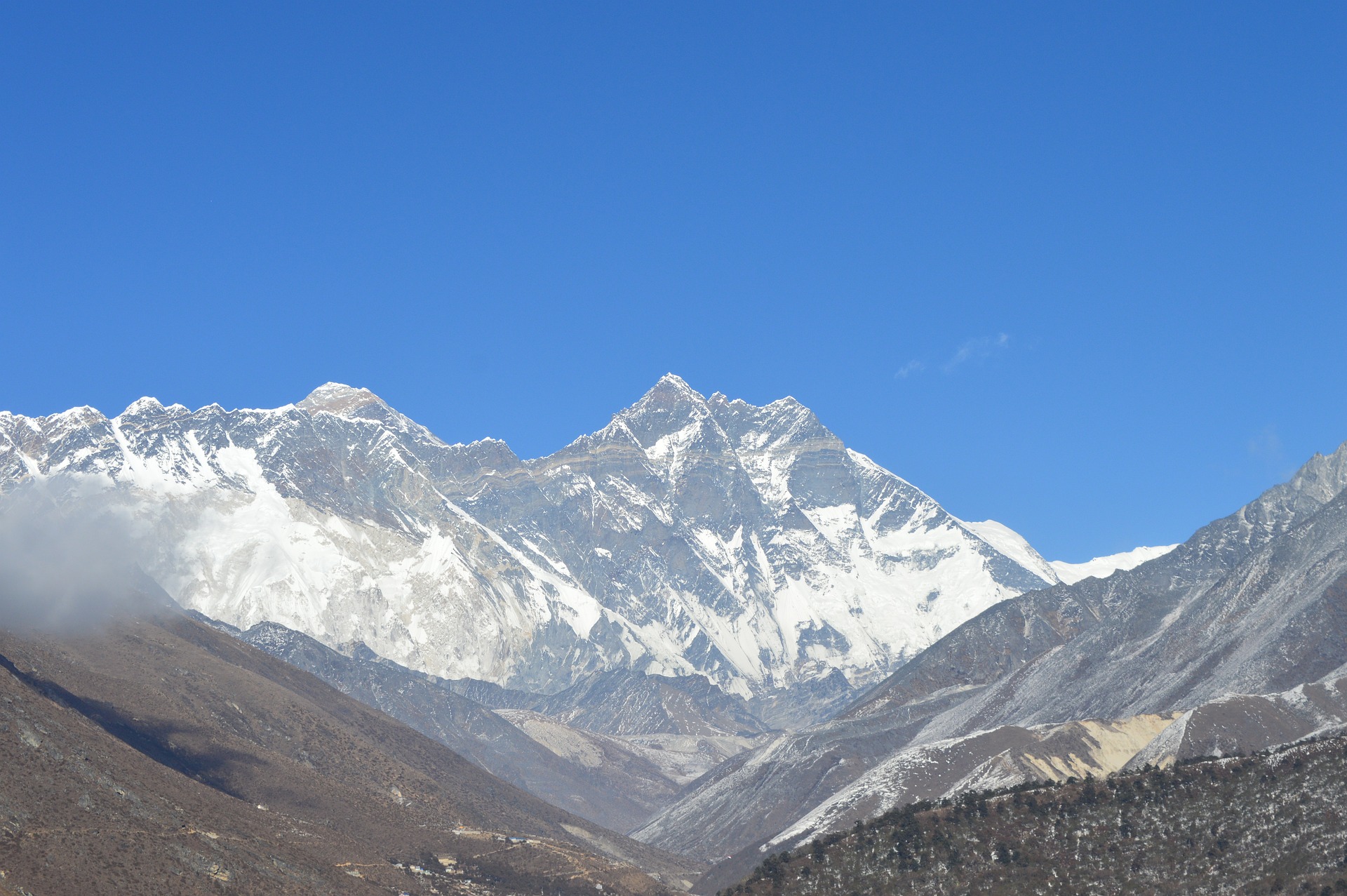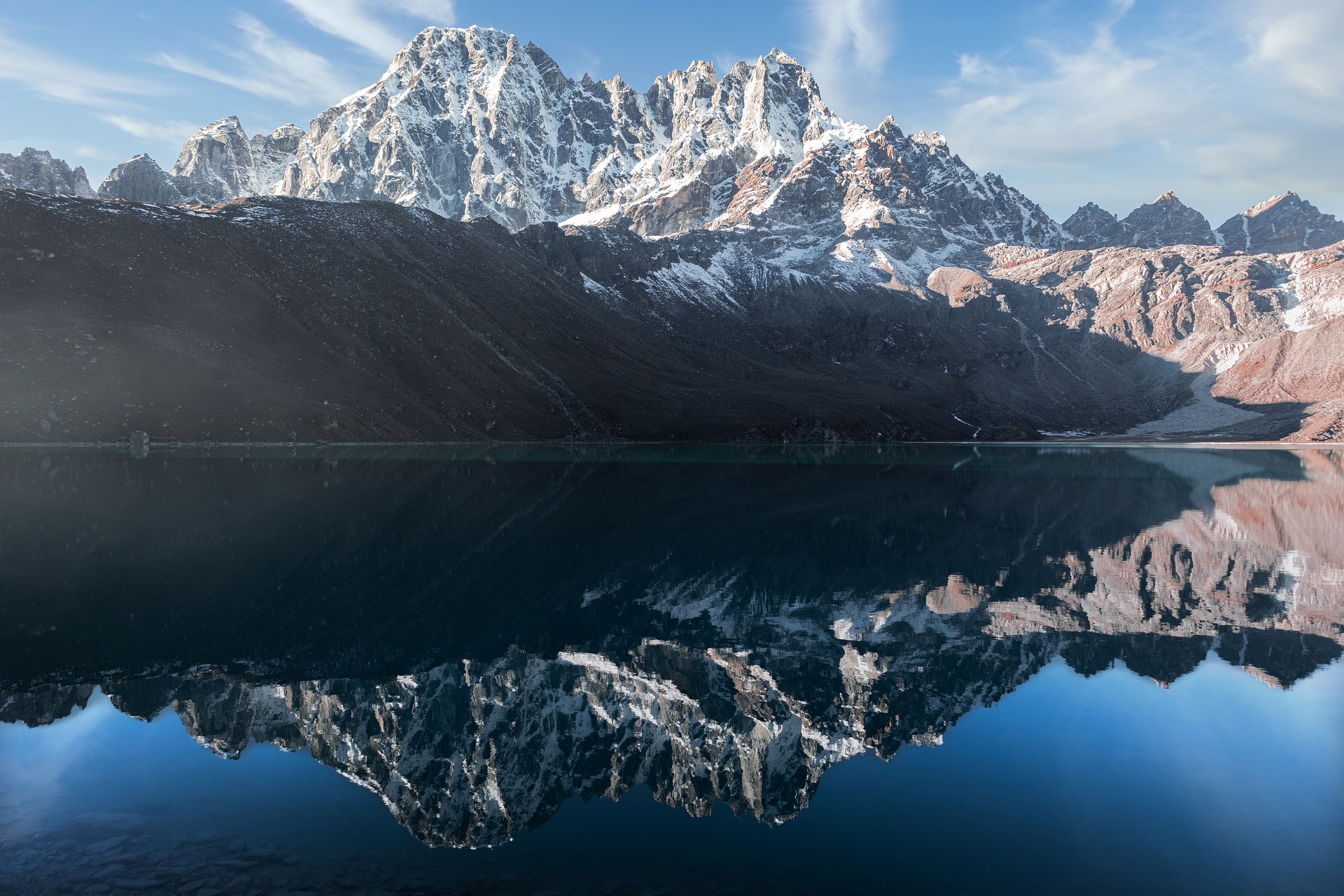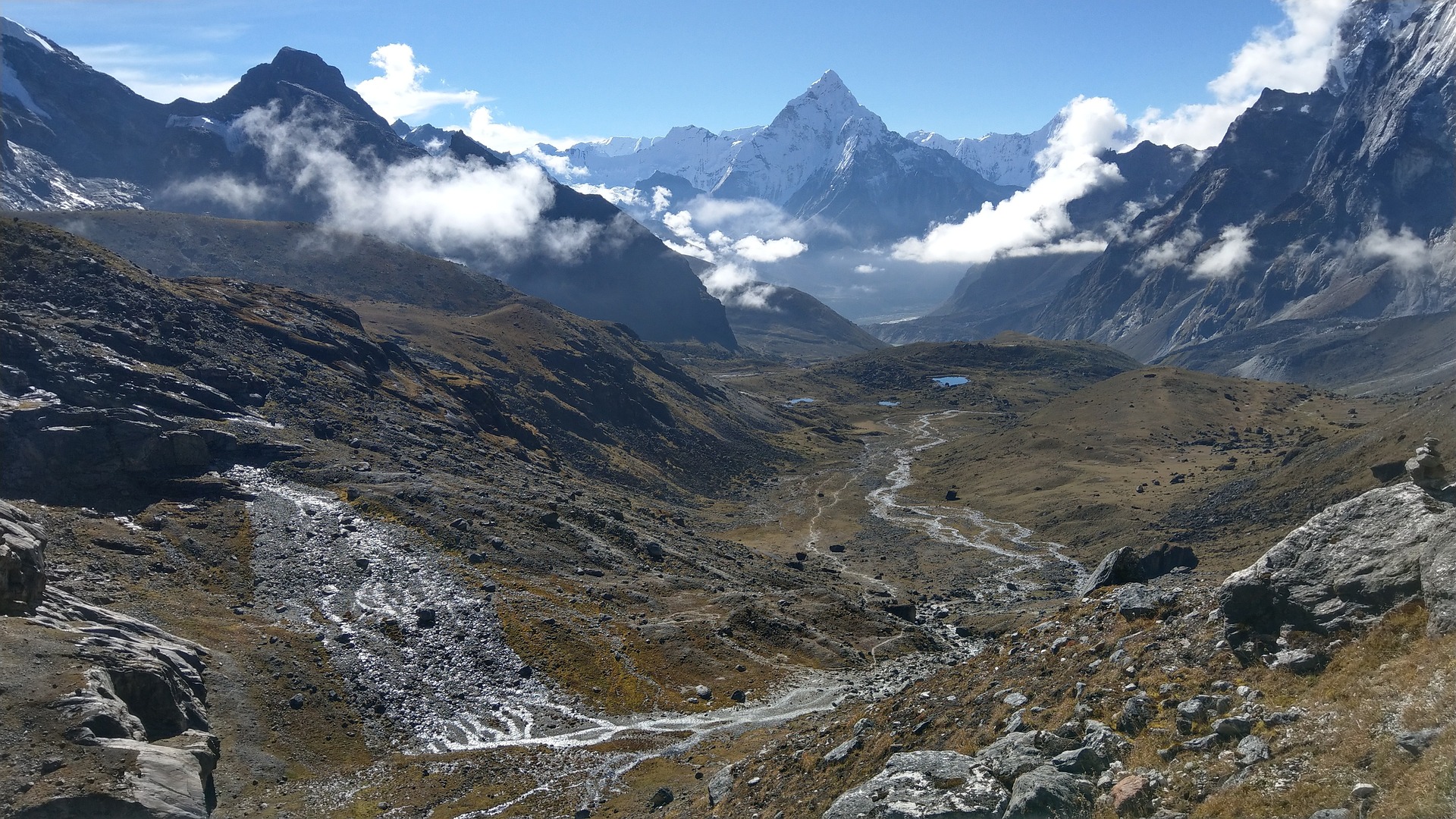Sagarmatha National Park stands as a testament to nature’s magnificence and the indomitable spirit of the Sherpa people. Established in 1976, this sprawling expanse covers 1,148 square kilometers in the Khumbu region of Nepal. Home to the world’s highest peak, Mount Sagarmatha (Everest), this national park has earned its UNESCO World Heritage Site status.
A Symphony of Nature and Culture
The park’s rugged terrain, ranging from 2,845 meters at Monjo to the awe-inspiring heights of Everest at 8,848 meters above sea level, encompasses the upper catchment areas of the Dudhkoshi and Bhotehoshi Rivers. The Dudhkoshi and Imja Khola rivers carve through deep valleys. They unveil a pristine wilderness adorned with glaciers, deep ravines, and dramatic U-shaped upper valleys.
The Sherpa people, deeply intertwined with Buddhist teachings, call this region home. Villages like Namche Bazar, Tengboche, Thame, Khumjung, and Pangboche breathe life into the landscape. Similarly, monasteries like Tengboche serve as cultural hubs for religious celebrations. The park’s uniqueness lies not only in its geological wonders but also in the Sherpa’s commitment to cultural preservation. The preservation efforts include their traditional practices that emphasize respect for all living beings.
History of Sagarmatha National Park
Sagarmatha National Park’s recognition began in 1973 when the concept was first announced at the WWF’s 3rd International Congress. Officially established on July 19, 1976, the park has since become a sanctuary for endangered wildlife, including the elusive snow leopard and the charming red panda.
In 1979, UNESCO acknowledged the park’s superlative natural characteristics by inscribing it on the World Heritage Site list. The commitment to conservation extends beyond the core area, with a Buffer Zone in 2002, covering an additional 275 square kilometers and incorporating settlements within the park. Further recognition came in 2007 when Gokyo lakes were designated as Wetlands of International Importance under the Ramsar Convention.
Guardians of the Himalayas
Beyond its cultural and ecological significance, Sagarmatha National Park shoulders the responsibility of monitoring the impacts of global warming and climate change on the flora, fauna, and Sherpa communities. As a major source of glaciers, the park provides invaluable freshwater benefits downstream, emphasizing the interconnectedness of nature and human well-being.
Geographic Features of Sagarmatha National Park
Sagarmatha National Park boasts a rugged landscape, characterized by towering peaks and deep valleys. The terrain is marked by dramatic changes in elevation, from the lower regions at Monjo to the breathtaking heights of Mount Sagarmatha. Visitors will encounter steep ravines and precipitous cliffs, showcasing the geological diversity that characterizes the region. The lower regions feature alluvial and colluvial deposits, forming a delicate balance between harsh rock formations and more hospitable soil.
Upper Catchment Areas of Dudhkoshi and Bhotehoshi Rivers
The park encompasses the upper catchment areas of two mighty rivers, Dudhkoshi and Bhotehoshi. These rivers originate within the park, carving their way through the challenging terrain, creating a vital network of waterways.
Prominent Peaks
The skyline of Sagarmatha National Park is dominated by majestic peaks, including the world’s highest, Sagarmatha (Mt. Everest). Other prominent giants like Lhotse, Cho Oyu, Thamserku, Nuptse, Amadablam, and Pumori grace the horizon, forming an awe-inspiring panorama for visitors.
Unique U-shaped Upper Valleys and Glacial Formations
The upper valleys within the park showcase a distinctive U-shaped morphology. The landscape is of glacial formations, such as the Nangpa Glacier on the Bhote Kosi and the Ngozumpa Glacier on the Dodh Kosi. These glaciers, spanning vast lengths, contribute to the park’s mesmerizing and dynamic geography.
The undulating terrain has rocky outcrops, providing a challenging yet captivating backdrop for trekkers and climbers. Baruntse, Lhotse, Nuptse, Pumo Ri, Guachung Kang, Cho-Oyu, and Nangpai Gosum are just a few examples of the imposing peaks that define the park’s skyline.
Biodiversity in Sagarmatha National Park
Flora and Fauna
The lower reaches of the park unveil a rich biodiversity, with pine and hemlock forests. In these altitudes, wildlife such as musk deer, martens, and the charming Himalayan mouse hare (pika) thrive. Ascending to higher altitudes, fir, juniper, birch, and vibrant rhododendron forests become the dominant flora, providing a striking backdrop against the snow-covered peaks.
The higher reaches of Sagarmatha National Park are home to unique plant communities and elusive fauna. The rare red panda, the majestic snow leopard, Himalayan tahr, and the agile marten navigate the challenging terrain. Overhead, more than 118 species of birds, including the resplendent Impeyan pheasant, the elusive snow cock, and the vibrant blood pheasant are present in the park.
Gokyo Lakes and the Alpine Zone
Nestled within the high reaches of the park, the Gokyo Lakes stand as jewels of the alpine zone. Surrounded by snow-capped peaks, these lakes, including Dudh Pokhari, Gokyo Cho, and Thonak Cho, provide a habitat for alpine vegetation. Patches of vibrant moss campion, alpine gentian, and dwarf willows add color to the rocky terrain, thriving in the harsh yet picturesque alpine environment.
Impact of Climate Change on Glacial Retreat
The relentless advance of climate change is visibly impacting the park’s glaciers, influencing the distribution of flora and fauna. As glaciers, like the Ngozumpa Glacier, undergo retreat, they reveal new areas for colonization by plants adapted to cooler conditions. Alpine flora, including saxifrages and cushion plants have grown in these changing landscapes.
The Sherpa Way of Life in Sagarmatha National Park
Sagarmatha National Park is not merely a tourist destination but a living testament to sustainable coexistence. With over 2,500 Sherpa residents, the park harmonizes nature and culture seamlessly. The Sherpas, residing in over 20 villages, have safeguarded their heritage for centuries through traditional practices, such as the restriction of animal hunting and a profound reverence for all living beings.
Tourism, a key driver of the local economy, has surged from 3,600 visitors in 1979 to over 25,000 in 2010. This influx has not only elevated living standards but also facilitated initiatives like the Buffer Zone program, a strategic move to enhance conservation efforts while fostering socio-economic development.
Notable Villages
1) Namche Bazar
The bustling hub and gateway to Everest, Namche Bazar welcomes trekkers with its vibrant market and panoramic views. It serves as a cultural crossroads, where visitors and locals intermingle against a backdrop of soaring peaks.
2) Tengboche
Beneath the shadows of Ama Dablam, Tengboche is home to the renowned Tengboche Monastery. The village offers a serene retreat, inviting travelers to immerse themselves in the spiritual aura of the Himalayas.
3) Thame
A tranquil village cradled in the mountains, Thame is a cultural gem with its own distinct charm. The warm hospitality of the Sherpa inhabitants and the views of surrounding peaks make Thame a captivating stop.
4) Khumjung
Tucked in the Khumbu Valley, Khumjung is known for its picturesque setting and the Hillary School, founded by Sir Edmund Hillary. The village provides a glimpse into Sherpa life, with traditional homes dotting the landscape.
5) Pangboche
A sacred enclave, Pangboche is adorned with ancient monasteries and chortens. It stands as a testament to the Sherpa commitment to preserving their cultural heritage amidst the grandeur of the Himalayas.
Role of Monasteries in Cultural Preservation
Monasteries stand as spiritual beacons, guiding both Sherpas and visitors on their journeys. Tengboche, Thame, Khumjung, and Pangboche host monastic traditions that transcend generations. These sacred spaces not only serve as religious centers but also as repositories of Sherpa history, art, and traditions.
The monasteries, adorned with intricate murals and vibrant prayer flags, echo with the chants of monks, fostering an atmosphere of spiritual serenity. Festivals like Dumje and Mane Rumdu, celebrated with grandeur, exemplify the unbroken thread connecting the Sherpa people to their cultural roots.
Traditional Practices
At the core of Sherpa culture lies a profound respect for the natural world. Traditional practices, handed down through generations, emphasize harmony with the pristine surroundings. From the intricacies of yak herding to the sustainable use of resources, the Sherpas exemplify a balanced coexistence with the fragile ecosystem of Sagarmatha National Park.
Sherpa customs include a deep reverence for the mountains, considering them sacred. The practice of avoiding animal hunting and slaughtering aligns with their commitment to non-violence and respect for all living beings. These practices, woven into daily life, contribute to the park’s conservation efforts, creating a harmonious synergy between human presence and the untouched wilderness.
Tourism and Economic Impact in Sagarmatha Region
The allure of Sagarmatha National Park has drawn a steadily increasing number of visitors over the years. From humble beginnings in 1979, with 3,600 enthusiasts exploring its wonders, to the thriving tourism hub it is today, welcoming over 25,000 adventurers in 2010. The park’s popularity as a trekking and mountaineering destination has soared, placing it firmly on the global travel map.
Contribution to the Local Economy and Living Standards
The influx of tourists into Sagarmatha National Park has been a catalyst for positive change in the local economy. The once-isolated Sherpa villages, including Namche Bazar, Tengboche, and Pangboche, now thrive with economic opportunities. Local businesses, from tea houses to souvenir shops, have flourished, creating jobs and sustainable income.
There’s a tangible enhancement in living standards. Improved access to education, healthcare, and infrastructure reflects the positive socio-economic impact.
Buffer Zone Program and Its Role in Socio-Economic Development
Recognizing the need to balance conservation with community welfare, Sagarmatha National Park implemented the Buffer Zone program. Initiated with the dual purpose of enhancing protection for the park and fostering socio-economic development, this innovative approach has become a model for sustainable conservation worldwide.
The Buffer Zone, established in 2002, covers an additional 275 square kilometers and includes settlements within the park. Through a revenue plow-back system, a portion of the entry fees and other revenues from tourism activities directly fund community projects. This reinvestment not only fortifies conservation efforts but also empowers local communities.
Education, healthcare, and infrastructure projects, fueled by the Buffer Zone program, have become instrumental. This symbiotic relationship between conservation and socio-economic development exemplifies how responsible tourism can be a driving force for positive change in ecologically sensitive regions.
Activities To Do in Sagarmatha National Park
Sagarmatha National Park, with its towering peaks and rich cultural heritage, beckons adventurers with a plethora of immersive activities. Each experience unfolds a unique facet of this UNESCO World Heritage Site, promising unforgettable memories.
1) Climbing Adventures
Sagarmatha National Park, a haven for mountaineers, offers a range of exhilarating climbing experiences amidst the majestic Himalayan peaks. Beyond the iconic Mount Everest, here are some noteworthy summits for those seeking the thrill of high-altitude adventures:
Mount Everest (Sagarmatha) – 8,848 meters
The crown jewel of Sagarmatha National Park, Mount Everest stands as the world’s highest peak. Climbing Everest is the ultimate aspiration for many mountaineers, testing their skill, endurance, and determination. The South Col route from Nepal and the North Col route from Tibet offer challenging yet rewarding paths to the summit.
Lhotse – 8,516 meters
Adjacent to Everest, Lhotse presents an awe-inspiring challenge for climbers. The Lhotse Face, an imposing ice and rock wall, poses a formidable obstacle on the route to the summit. The South Col route, shared with Everest, adds an extra layer of complexity to this ambitious climb.
Nuptse – 7,861 meters
Often overshadowed by its towering neighbors, Nuptse offers a technical ascent with challenging rock and ice sections. Climbers are rewarded with stunning views of Everest and Lhotse from the summit. The climb demands both technical proficiency and acclimatization to high-altitude conditions.
Ama Dablam – 6,812 meters
Ama Dablam, with its iconic pyramid shape, stands as one of the most visually striking peaks in the region. The climb is a combination of rock, ice, and mixed terrain, providing a thrilling yet technical ascent. The summit offers panoramic views of Everest, Lhotse, and the Khumbu Valley.
Island Peak (Imja Tse) – 6,189 meters
Island Peak, nestled in the heart of the Khumbu region, is a popular choice for climbers seeking their first Himalayan summit. The climb combines trekking and mountaineering, making it accessible to those with basic climbing skills. The summit provides breathtaking views of the surrounding peaks.
2) Everest Base Camp Trek

Embark on the legendary Everest Base Camp Trek, a multi-day journey that takes you through picturesque Sherpa villages, rhododendron forests, and suspension bridges strung across deep valleys. The trail, adorned with prayer flags and chortens, gradually leads to the iconic base camp of the world’s highest peak, Mount Everest. Along the way, encounter the warm hospitality of Sherpa communities and witness the mesmerizing beauty of the Himalayas.
3) Gokyo Lakes Exploration

Delve into the surreal beauty of the Gokyo Lakes, a series of turquoise jewels cradled amidst snow-capped peaks. The Gokyo Lakes trek offers not only breathtaking vistas but also a chance to ascend Gokyo Ri for a panoramic view that includes Cho Oyu, Everest, and Makalu. The tranquil ambiance of this pristine location provides a serene escape into the heart of the Khumbu region.
4) Khumbu Glacier Walk
Traverse the ancient Khumbu Glacier, a mesmerizing icefield leading to Everest Base Camp. This glacier walk not only provides an up-close encounter with glacial formations but also showcases the geological wonders of the region. Engage with experienced guides to unlock the secrets of this frozen landscape.
5) Wildlife Spotting
As you trek through diverse ecosystems, keep a keen eye out for the park’s elusive wildlife. The snow leopard, red panda, Himalayan tahr, and a myriad of bird species inhabit these high-altitude landscapes. Engage in wildlife spotting sessions led by experienced guides to enhance your understanding of the region’s unique fauna.
6) Cultural Immersion
Immerse yourself in the authenticity of Sherpa culture. Wander through the village’s narrow lanes, marvel at traditional stone houses, and visit the Hillary School, a testament to the region’s commitment to education. Interact with locals, witness traditional ceremonies, and gain insights into the day-to-day lives of Sherpa communities.
7) Helicopter Tour of the Himalayas

Elevate your experience with a helicopter tour that soars above the majestic Himalayan peaks. Marvel at Everest, Lhotse, and Nuptse from an aerial perspective, capturing panoramic views that few get to witness. This exhilarating adventure offers a bird’s-eye view of the awe-inspiring landscapes that define Sagarmatha National Park.

